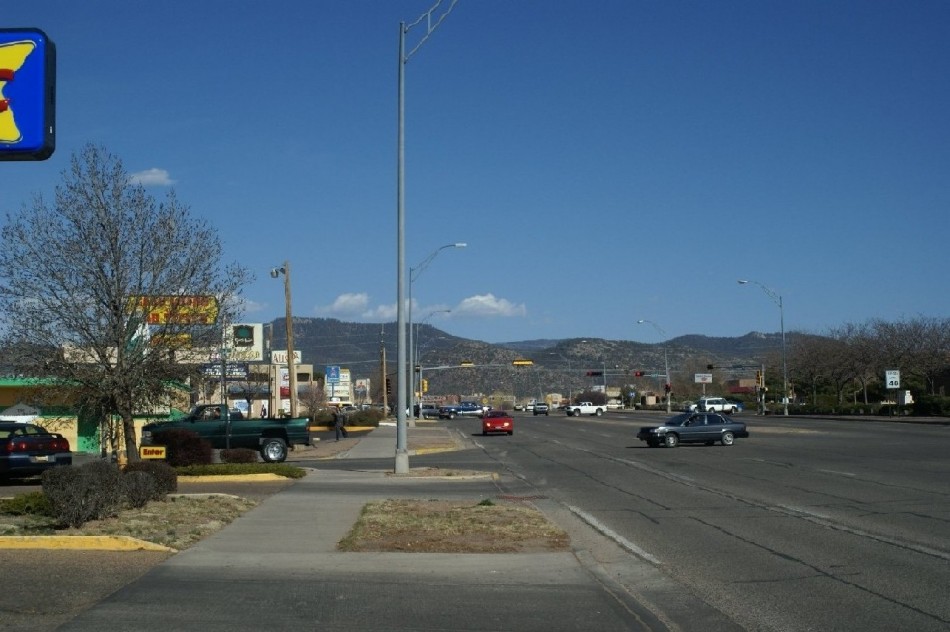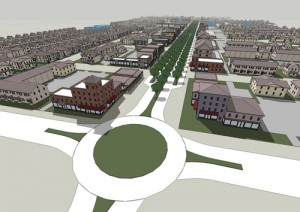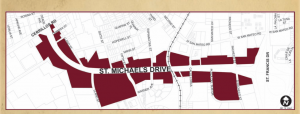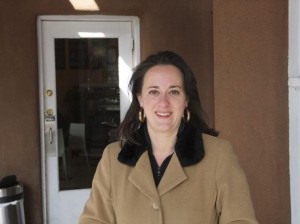
Same As It Never Was: Re-Visionizing St. Michael’s Drive through Re-MIKE
There has probably been no more sparky political question in our home burg than “what’s the future for a (more) urban Santa Fe?” If this city is “different,” it’s also been in recent history same as many other places — unkind to real-estate and civic values that include density and pedestrian-friendly streetscapes along with single-family sprawl and parkview acreage.
A September 21-23 Re-MIKE “Kickoff” of what is being called an “urban prototyping and previtalization” project, takes place this weekend at the mall at St. Michael’s Village West, 1628 St. Michael’s Drive.
Here will be the locus where ideas around a revitalized St. Michael’s Drive corridor will be tried out, shown off, demonstrated and invited for comment and participation by you. (See Remikeable.com. Also see vivasantafe.com.)
If Santa Fe can even loosely be compared to New York and its history of gentrification with and without artists, consider that what the Railyard is to Chelsea, St. Michael’s Drive is to Fort Greene or East New York — an unfolding borough-in-spirit-if-not-name. St. Mike’s possesses some element of “frontier” (commercial vacancy rates, and poverty in the nearby residential neighborhoods), plus “amenities” (Santa Fe University of Art and Design; an arroyo; public transportation). In sum, opportunity and challenge.
Here’s where we the people come in. We’re being asked to populate the community involvement portion of a weekend whose planners have constellated an opportunity for feedback as well as buy-in to the idea that St. Mike’s might become a new “zone” in Santa Fe, overlaid with some more urban practices such as higher building walls and closer streetscapes.
 Parts of the City Council are in.
Parts of the City Council are in.
Prelude to the present is that in 2011, a Santa Fe City Council resolution (sponsored by former councillor Rosemary Romero and councillor Rebecca Wurzburger and signed by Mayor David Coss in the early days of March 2011) directed city staff to begin to pay attention to St. Mike’s in a more formalized way. This followed one try in which city and private partners including Santa Fe Art Institute teamed up to apply for a national grant– through the NEA’s Our Town initiative, concentrating on “creative placemaking.” A later effort applied for funds to Housing and Urban Development. Neither one succeeded.

Mural project by Yatika Fields and Kofie at Re-MIKE
This latest city-instigated work on St. Mike’s has been funded through almost $50,000 in contracts from City Economic Development ($20,000 to Story of Place Institute; $17,000 to Anagr.am Design; $10,000 for project team stipends), as well as a $10,000 grant from Kindle Foundation in Santa Fe. Businesses including Christus-St. Vincent’s are also engaged.
This visualizing a future for St. Mike’s is actually a sequel to earlier planning activity dating as far back as five to seven years. Roy Wroth, an urbanist, worked up a Second Street “Triangle District” plan followed by a St. Mike’s redevelopment plan, proposing redevelopment along “three nodes” of the corridor (2009). In 2010, Worcester Polytechnic Institute students drafted a proposal to help provide “tools to visualize the future redevelopment of the area.” And more recently, the Santa Fe Association of Realtors contracted a study by firm Albert Moore and Associates that foresaw an eventual build-out of over 1000 housing units on some 14 properties in the “district.” At this writing, UNM graduate seminar led by professor Moises Gonzales is working on a “form-based code” that may eventually be adopted into what’s called a “zoning overlay district” for St. Mike’s.


Form-based code example in Wyoming, Michigan; from a newurbanism blog
Form-Based Code
Form-based code, in the prevailing architects’ and planners’ language, is an antidote to conventional zoning that defines development by land use: commercial or residential, for example. Form-based code “address(es) the relationship between building facades and the public realm, the form and mass of buildings in relation to one another, and the scale and types of streets and blocks.” The code is “regulatory,” not advisory, meaning if enacted, it makes the rules.
Form-based code, has also been controversial in its relationship to a brand of urbanism that has for 32 years been called the “new urbanism” and has templated that code as seen in cities like Seaside, Florida; or the movie The Truman Show. The new urbanism’s founders were Andres Duany and Elizabeth Plater-Zybeck of Duany Plater-Zybeck Associates, Duany being the person whom The Atlantic in 2010 called “the man who reinvented the city.”
Form-based code planners define the code as dealing in the “character” of a neighborhood through its urban attributes (density-height-streetscapes), and say that can achieve a “community vision based on time-tested forms of urbanism,” according to the Form-Based Code Institute.
But the meaning of “time-tested” and the difficulty of establishing a single vision for a form-based code that “incorporates multiple visions,” have led to vocal criticism from land-use and other critics including Lolita Buckner-Inness, an associate professor of law at Cleveland State University. Speaking in 2008 at a conference on private property rights, Buckner-Inness said:
…When you talk about form-based code, you’re really talking about one of the principal tools of what’s called the new urbanism, sort of a way of getting back to the “old urbanism” and the old city . . . The new urbanism, like the old urbanism—that’s deeply contested. The city that you and I may remember may be very different than the city that somebody else remembered. . . . We all remember and lived in different types of cities, and so there’s no way that we’re going to design something that reflects a vision. There is no single vision. There are multiple visions that could never begin to be incorporated in any one single vision, So that’s another problem.
 Re-MIKE appears in part to have anticipated the problem in contracting Story of Place Institute to record and document multiple community “stories”. If this strikes any reader as redolent of Railyard planning processes a decade ago and more, it bears mention that the 2011 City Council resolution states hopes of generating “creative and cultural industries along the corridor, and establishing a vibrant and innovative community.”
Re-MIKE appears in part to have anticipated the problem in contracting Story of Place Institute to record and document multiple community “stories”. If this strikes any reader as redolent of Railyard planning processes a decade ago and more, it bears mention that the 2011 City Council resolution states hopes of generating “creative and cultural industries along the corridor, and establishing a vibrant and innovative community.”
The city has already invested substantially in St. Mike’s, “amenities,” contributing $35 million including deferred maintenance costs to the purchase of the former College of Santa Fe campus by Santa Fe University of Art and Design, which fronts the drive.The last Census discerned that residential communities near to St. Mike’s (but less of an immediate-neighboring issue than in the Railyard,), live at 80% of federal poverty level. And state interests pertain as well, as the state of New Mexico owns land nearby, where an “economic development park” has been forseen. St. Mike’s is a state-owned road.
Who’s Who
![]() The Re-MIKE steering committee includes Kate Noble, economic development specialist with the City of Santa Fe; Zane Fischer (right), a principal of Anagr.am Design and former columnist for the Santa Fe Reporter; Daniel Werwath; and Shannon Murphy of the After-Hours Alliance.
The Re-MIKE steering committee includes Kate Noble, economic development specialist with the City of Santa Fe; Zane Fischer (right), a principal of Anagr.am Design and former columnist for the Santa Fe Reporter; Daniel Werwath; and Shannon Murphy of the After-Hours Alliance.
Fischer is also a leader for the city- and local-business-funded initiative MIX Santa Fe, a monthly mixer that both he and Noble described as providing a model for how Re-MIKE has been constituted, largely in the community input process.
Fischer explained by phone that Re-MIKE language may be dealing with the buzzwords creative and place, but is not strictly “creative placemaking,” as understood in national funding parlance.
“We don’t need to hang our hats entirely on that peg. (But) arts and creative identities are central to Santa Fe identity. We don’t have artists engaged in thinking about public policy as much as they ought to do, both for us as a community to benefit, and for artists thinking the city or some entity ought to do something for them,” Fischer said.
The planner addressed how critical community input is, although one big unknown remains the relationship between community input and the form-based code issue that will assign at least some draft regulations to things including building height and setbacks. On display this weekend will be mock 36-foot wall heights, Fischer said.
“The event is not about proscribing outcomes but developing them with the input of people who attend,” Fischer said.
As to relationships between MIX Santa Fe and Re-MIKE, MIX has been a data mine for the city (with the editorial caveat that the MIX organization plays dual roles as program presenters and data analysts). MIX Santa Fe’s constituency has some overlap with the Re-MIKE process in that MIX has concentrated on people in their 20s and 30s, for whom MIX is a cocktail mixer and networking soiree. Out of MIX’s question-and-answer model (Q: “What’s the freaking problem?” A: “Nightlife”) some new grassroots orgs have formed that are having powerful impact in modeling not only how urban overlay might look but how much fun it is. Viz., the After-Hours Alliance formed up to start to catalyze more nightlife and more communication about it (the same group just responsible for the second annual AHA Fest at the Railyard).
On the so-called entrepreneurial track, a “BizMIX challenge” this May invited people with startup business ideas to submit them for funding. $9000 was distributed among four winners, with The Way We Grow (a modular “grow bag”) receiving $5000 and Pants Off (an underwear company) getting $600. Both of those will be pop-up businesses displaying at Re-MIKE this weekend. (Also awarded funds through BizMIX were BetaMapper, receiving $2500, and $900 to Soapbox Kids).

Kate Noble
I asked Kate Noble of the city’s economic development division what independent evaluation mechanisms are being put in place for Re-MIKE.
“They will be in the community,” she answered.
“We will be following up through extensive charrettes with the UNM students” (the graduate school class, currently evaluating St. Mike’s and form-based code adoption.)
“I would look to the project teams to be the independent voice of (Re-MIKE),” Noble said.
Calling Re-MIKE “a community development exercise,” Noble continued that “the main point of the event is to inform the drafting of an overlay district which will include the form-based code but may also include incentives for development. We hope that what comes out of it is an identity and a more unified community vision around the area.”
Describing “something that really comes from the community and is a lot more organic in its process,” Noble’s answer deals in another caution raised by Bruckner-Inness on form-based code: If it’s “collaborative … it’s supposed to be something between government and citizens.”
The Tracks

Candy Chang, artist and community proponent, speaks at Re-MIKE Friday at 6, sponsored by Creative Santa Fe
When you show up this weekend for Re-MIKE, you’ll have a chance to see presentations in ecology, entrepreneurial development and transportation — all “tracks” for the train of process.
The Santa Fe Innovation Park presents a pop-up renewable generation “Energy Village” with displays, electric vehicles, and passive efficiency techniques; a Smart Home demo; and an exploration of what a future “neighborhood energy network” might look like. The Santa Fe landscape firm Surroundings will present demos for green space and parklets.
Creative Santa Fe is hosting the keynote speaker, Candy Chang, who will speak at 6 p.m. Friday September 21 at the M&J Event Center ($10 public, $5 student tickets from ticketsantafe.org). Projects on Chang’s website include “It’s Good to Be Here (Feeding New Orleans)” about which the artist writes: “Ask people why they live here and they get emotional. It’s because there was an instant connection.”
“Loving your city” is a leitmotif of Chang’s work.
Also on hand will be Santa Fe University of Art and Design contemporary music students, Meow Wolf ,Wise Fool and others (See Remikeable dot com for the evolving schedule). Film screenings, a Youth Works car show, and artists’ pop-ups and art projects (including Edie Tsong, whose Snow Poems project was just the crowd-source winner at SPREAD 3.0) will also be there.
